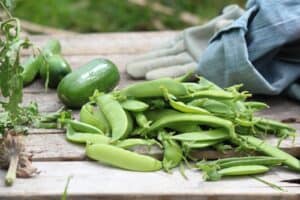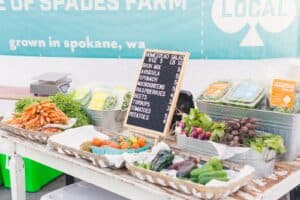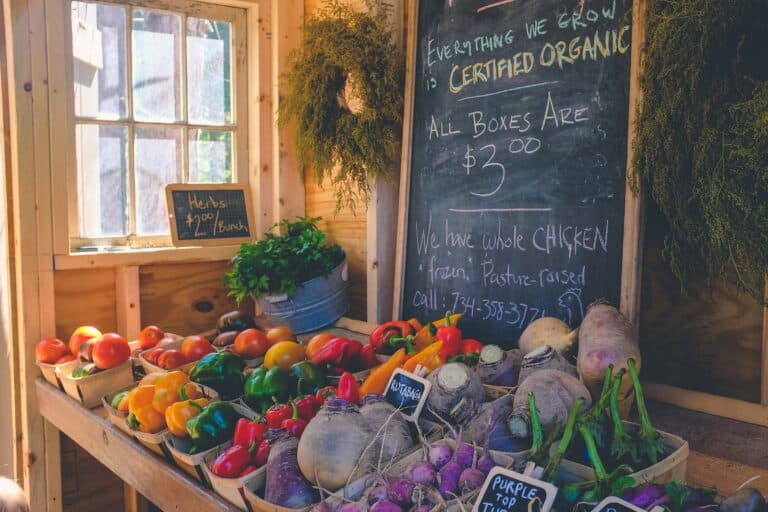In today’s fast-paced world, our food choices often prioritize convenience over everything else. We’re used to having all kinds of fruits and vegetables available at our fingertips, regardless of the season. However, there’s a compelling case for returning to the roots of our food system and embracing the practice of eating seasonally and locally. In this comprehensive guide, we’ll explore the numerous advantages of opting for seasonal and locally sourced foods, both for your health and the environment.
Understanding Seasonal and Local Eating

Before we explore the myriad benefits, it’s essential to establish a clear understanding of what eating seasonally and locally entails.
Seasonal Eating Defined
At its core, seasonal eating is a straightforward concept. It means selecting foods that are currently in season within your specific region. These foods are naturally ripe and at their flavor peak.
The Local Connection
Moreover, the essence of seasonal eating is closely intertwined with the idea of sourcing these foods locally. This involves obtaining your fresh produce and other food items from nearby producers, which can include farmers markets and neighboring farms.
Connecting to Your Local Food System
Embracing seasonal and local eating is more than just a dietary choice; it’s a way of connecting with your local food system. It ensures that the fruits and vegetables on your plate are harvested at their peak of freshness, providing you with the most flavorful and nutritious options available.
The Nutritional Power of Seasonal Foods
When you make the choice to eat seasonally, you’re embarking on a journey that aligns your diet with the rhythm of nature. It’s a decision that goes beyond taste and extends to the remarkable nutritional value of these foods.
Harvested at Their Prime
Seasonal foods are nature’s gifts at their absolute prime. Picture plump, ripe strawberries, bursting with flavor, and vibrant green beans at the peak of their crispness. This is the magic of seasonal produce.
Exquisite Taste and Nutritional Value
The exceptional taste of seasonal foods is no coincidence. It’s a direct result of being harvested at the perfect moment. Beyond taste, seasonal fruits and vegetables offer an array of essential nutrients. Take strawberries, for instance, which not only delight your palate but also deliver higher levels of vital nutrients like vitamin C when compared to their out-of-season counterparts. These out-of-season options are often harvested prematurely and endure long journeys, diminishing both their taste and nutritional content.
Health Benefits of Eating Seasonally and Locally

- Nutrient-Rich Fare: Seasonal fruits and vegetables are packed with vitamins and minerals, which can help boost your overall health. The higher vitamin C content in seasonal produce, for instance, strengthens your immune system.
- Better Taste: Seasonal foods are renowned for their superior taste and texture. The crispness of a locally grown green bean or the sweetness of a ripe, in-season peach is a testament to this.
- Reduced Food Miles: Opting for local and seasonal food drastically reduces “food miles,” the distance your food travels from farm to plate. This not only lowers transportation costs but also slashes greenhouse gas emissions, contributing to the fight against climate change.
- Supporting Local Economies: When you buy from local farmers, you’re directly contributing to your community’s economy. Local businesses thrive, jobs are created, and your dollars stay within your region, benefiting your neighbors and friends.
Environmental Impact: Beyond Food Miles
The environmental advantages of eating seasonally and locally extend far beyond reducing food miles. Here’s how your choices positively impact the environment:
- Biodiversity Preservation: Supporting local farms often means promoting biodiversity. Local farmers tend to grow a wider variety of crops, helping preserve the genetic diversity of plants.
- Reduced Carbon Footprint: By consuming foods grown nearby, you contribute to lower carbon emissions. Unlike foods that travel long distances, locally sourced items have “zero food miles,” which means less fuel is burned during transportation.
- Sustainable Farming Practices: Many local farmers prioritize sustainable farming methods, such as organic or regenerative agriculture. These practices have a more favorable environmental impact, reducing soil erosion and chemical runoff.
Practical Tips for Embracing Seasonal and Local Eating

Eating seasonally and locally is not a difficult feat; it just requires a bit of planning. Here are some practical tips to get you started:
- Visit Local Farmers Markets: Farmers markets are treasure troves of seasonal delights. They offer fresh produce and the chance to connect with local farmers.
- Join a CSA (Community Supported Agriculture): CSA programs allow you to subscribe to regular deliveries of locally grown produce. It’s a convenient way to enjoy seasonal foods.
- Grow Your Own: Even if you have limited space, you can cultivate herbs, tomatoes, or even a small fruit tree in your backyard or on a windowsill.
- Preserve Seasonal Surpluses: When certain fruits or vegetables are in abundance, consider preserving them by canning, freezing, or making jams and pickles.
Exploring the Diversity of Local Produce
One of the joys of eating locally is the rich diversity of produce you’ll encounter. From the vibrant hues of heirloom tomatoes to the earthy flavors of root vegetables like carrots and beets, local markets and grocery stores offer a colorful tapestry of choices. These local gems aren’t just delicious; they also support regional agriculture and often have a lower carbon footprint due to shorter transportation distances.
Minimizing Food Waste Through Local Eating
In our world of abundance, food waste is a pressing concern. However, by choosing to embrace local and seasonal eating, you can play a part in reducing food waste. How does this work? When you opt for foods that are in season, you’re more likely to consume what’s available, reducing the chances of fruits and vegetables spoiling before they’re eaten. This conscientious approach not only benefits your wallet but also helps conserve resources and minimize the environmental impact of food waste.
Eating Locally: Beyond the Farmer’s Market
While the local farmer’s market is a fantastic place to find fresh, seasonal goodies, it’s not the only option for those committed to eating locally. Many grocery stores are now actively promoting local produce, making it easier than ever to support regional farmers. Additionally, the rise of veg box subscriptions allows you to receive a curated selection of in-season produce right at your doorstep. These convenient alternatives ensure you can enjoy local and seasonal delights year-round, no matter where you live.
Recipes That Showcase Local and Seasonal Flavors

Incorporating local produce into your meals is not just about salads and raw vegetables. There’s a world of culinary creativity waiting to be explored. Local and seasonal ingredients can elevate your dishes to new heights of taste and nutrition. Whether you’re making hearty stews with root vegetables, crafting vibrant salads with seasonal greens, or indulging in fruit-based desserts with locally grown berries, there’s a recipe for every palate. Let’s explore some delectable examples that celebrate the beauty of local and seasonal eating.
Supporting Local Restaurants That Prioritize Seasonal Fare
Dining out can also be an opportunity to indulge in local and seasonal culinary experiences. Many restaurants now prioritize using locally sourced ingredients in their menus, providing a farm-to-table dining experience that highlights the freshest flavors of the season. By choosing to dine at these establishments, you not only savor delicious dishes but also support the local food economy and encourage more restaurants to adopt sustainable and seasonal practices.
Year-Round Local and Seasonal Eating
While some may think that local and seasonal eating is limited to certain times of the year, the truth is that this practice can be embraced year-round. Even in colder climates, you can find local produce, such as winter squash and hearty greens, that thrive in the chillier months. Veg box subscriptions often cater to seasonal variations and offer a delightful surprise of in-season produce each week, making it feasible to maintain your commitment to local and seasonal eating throughout the year.
Overcoming Challenges
Eating seasonally and locally presents a multitude of benefits, but it’s equally important to recognize and address potential challenges. One of the key hurdles is the limited availability of certain foods in some regions throughout the year. However, these challenges are not insurmountable and can be navigated with a dash of creativity and careful planning.
Don’t let occasional scarcity discourage you from the path of seasonal and local eating. Every effort you make, no matter how small, contributes to building a more sustainable and nutritious diet for yourself and the planet.
Final Thoughts: A Seasonal and Local Approach to Food
In conclusion, choosing to eat seasonally and locally is a decision that not only benefits your health but also has far-reaching positive effects on the environment and your community. It’s a return to the essence of nature, savoring the taste of fresh, nutritious foods, and supporting the local economy.
By reducing food miles, you play a part in mitigating climate change, preserving biodiversity, and endorsing sustainable farming practices. So, next time you’re at your local farmers market, savor the flavors of the season and know that you’re contributing to a healthier planet and a more vibrant community.
Other suggested articles:

